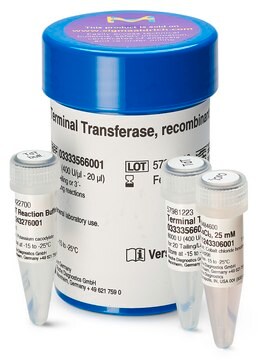Key Documents
DIUTPS-RO
Roche
Digoxigenin-11-dUTP, alkali-stable
Synonim(y):
Digoxigenin-11-dUTP, alkali-labile
About This Item
Polecane produkty
Próba
≥85% (HPLC)
Poziom jakości
Postać
solution
masa cząsteczkowa
Mr 1090.7
opakowanie
pkg of 125 μL (11558706910 [1 mM])
pkg of 5 × 125 μL (11570013910 [5x1 mM])
pkg of 25 μL (11093088910 [1 mM])
producent / nazwa handlowa
Roche
λmaks.
222 and 292 nm
22430 and 8780
temp. przechowywania
−20°C
Szukasz podobnych produktów? Odwiedź Przewodnik dotyczący porównywania produktów
Opis ogólny
Zastosowanie
fluorescent in situ hHybridization (FISH) and polymerase chain reaction (PCR)
Note: When this nucleotide is subjected to 0.1 - 0.5 NaOH at +15 to +25°C, the DIG moiety will remain attached. It is therefore ideal for use in DIG-labeled DNA that needs to survive exposure to alkaline treatment. However, if you intend to make a DIG-labeled probe that can be removed by alkali denaturation (e.g ., during stripping and reprobing of blots), do not use this alkali-stable preparation. Instead, use the alkali-labile form of DIG-11-dUTP.
Działania biochem./fizjol.
Cechy i korzyści
Resistance to alkali: The preparation is stable in the presence of 0.1 - 0.5M NaOH at +15 to +25°C.
Jakość
Function tested by RPL.
Uwaga dotycząca przygotowania
Storage conditions (working solution): A decomposition of approx. 5% may occur within 4 weeks at 15 to 25 °C.
Inne uwagi
Kod klasy składowania
12 - Non Combustible Liquids
Klasa zagrożenia wodnego (WGK)
nwg
Temperatura zapłonu (°F)
does not flash
Temperatura zapłonu (°C)
does not flash
Certyfikaty analizy (CoA)
Poszukaj Certyfikaty analizy (CoA), wpisując numer partii/serii produktów. Numery serii i partii można znaleźć na etykiecie produktu po słowach „seria” lub „partia”.
Masz już ten produkt?
Dokumenty związane z niedawno zakupionymi produktami zostały zamieszczone w Bibliotece dokumentów.
Klienci oglądali również te produkty
Nasz zespół naukowców ma doświadczenie we wszystkich obszarach badań, w tym w naukach przyrodniczych, materiałoznawstwie, syntezie chemicznej, chromatografii, analityce i wielu innych dziedzinach.
Skontaktuj się z zespołem ds. pomocy technicznej





